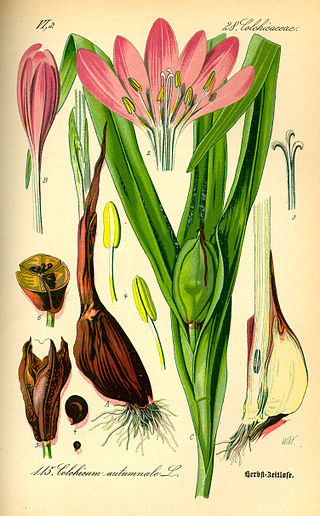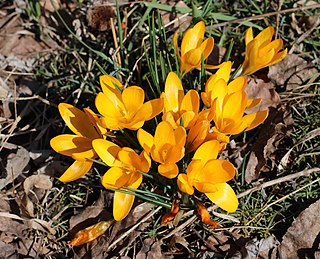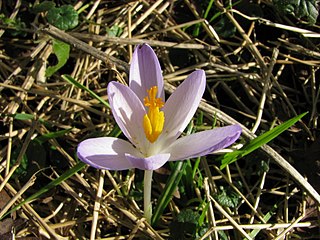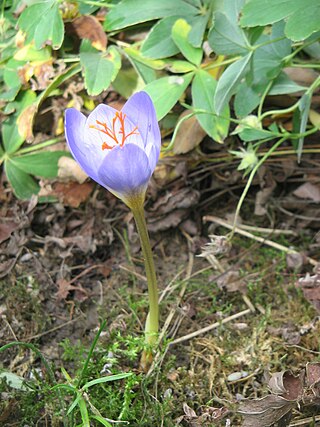
Crocus is a genus of seasonal flowering plants in the family Iridaceae comprising about 100 species of perennials growing from corms. They are low growing plants, whose flower stems remain underground, that bear relatively large white, yellow, orange or purple flowers and then become dormant after flowering. Many are cultivated for their flowers, appearing in autumn, winter, or spring. The flowers close at night and in overcast weather conditions. The crocus has been known throughout recorded history, mainly as the source of saffron. Saffron is obtained from the dried stigma of Crocus sativus, an autumn-blooming species. It is valued as a spice and dyestuff, and is one of the most expensive spices in the world. Iran is the center of saffron production. Crocuses are native to woodland, scrub, and meadows from sea level to alpine tundra from the Mediterranean, through North Africa, central and southern Europe, the islands of the Aegean, the Middle East and across Central Asia to Xinjiang in western China. Crocuses may be propagated from seed or from daughter cormels formed on the corm, that eventually produce mature plants. They arrived in Europe from Turkey in the 16th century and became valued as an ornamental flowering plant.

Colchicum is a genus of perennial flowering plants containing around 160 species which grow from bulb-like corms. It is a member of the botanical family Colchicaceae, and is native to West Asia, Europe, parts of the Mediterranean coast, down the East African coast to South Africa and the Western Cape. In this genus, the ovary of the flower is underground. As a consequence, the styles are extremely long in proportion, often more than 10 cm (4 in). All species in the genus are toxic.

Colchicum autumnale, commonly known as autumn crocus, meadow saffron, naked boys or naked ladies, is a toxic autumn-blooming flowering plant that resembles the true crocuses, but is a member of the plant family Colchicaceae, unlike the true crocuses, which belong to the family Iridaceae. It is called "naked boys/ladies" because the flowers emerge from the ground long before the leaves appear. Despite the vernacular name of "meadow saffron", this plant is not the source of saffron, which is obtained from the saffron crocus, Crocus sativus – and that plant, too, is sometimes called "autumn crocus".

Crocus banaticus, syn. C. iridiflorus, is a species of flowering plant belonging to the family Iridaceae, native to the Balkans, particularly in Serbia, Romania and south western Ukraine. It creates its own subgenus in the Crocus subfamily known as Crociris. It is a cormous perennial growing to 10 cm (4 in).

Crocus flavus, known as yellow crocus, Dutch yellow crocus or snow crocus, is a species of flowering plant in the genus Crocus of the family Iridaceae. It grows wild on the slopes of Greece, former Yugoslavia, Bulgaria, Romania and northwestern Turkey, with fragrant bright orange-yellow flowers. It is a small crocus (5–6 cm, despite the names of some cultivars, compared to the giant Dutch crocuses. Its cultivars are used as ornamental plants.

Crocus tommasinianus, the woodland crocus, early crocus, or Tommasini's crocus, is a flower named after the botanist Muzio G. Spirito de Tommasini (1794-1879). It is native to Bulgaria, Hungary, Albania, and the former Yugoslavia. It is often referred to as the early or snow crocus, but these terms are shared with several other species, although C. tommasinianus is amongst the first to bloom. Multiple plants are often called tommies in the horticultural trade.

Colchicum × agrippinum is a species of flowering plant in the family Colchicaceae. It is considered to be a hybrid between C. variegatum and C. autumnale, and not a true species, although this is not certain. The genus and the species are commonly called autumn crocus, naked lady or meadow saffron.

Colchicum cilicicum, the Tenore autumn crocus, is a species of flowering plant in the Colchicaceae family. A bulbous perennial, it bears deep rose-lilac flowers in late summer, with barely any chequered pattern on the petals (tessellation). It has a very noticeable white stripe down the centre of each petal, which gives it a star-like appearance at the base. The flowers tend to stand up to weather better than other colchicum blooms. The flowers appear before the strap-like leaves, giving this and other colchicum species the common name “naked lady”. Although colchicums are called “autumn crocuses” they belong to a different family than true crocuses. There are in fact autumn-flowering species of crocus such as Crocus sativus, which is the source of the spice saffron. Colchicum cilicicum, by contrast, is toxic if eaten.

Colchicum × byzantinum, the Byzantine meadow saffron, is a species of flowering plant in the family Colchicaceae with a long history of cultivation, and no certain place of origin. It is thought to be a hybrid of other species.

Tecophilaea cyanocrocus, the Chilean blue crocus, is a flowering perennial plant that is native to Chile, growing at 2,000 to 3,000 m elevation on dry, stony slopes in the Andes mountains. Although it had survived in cultivation due to its use as a greenhouse and landscape plant, it was believed to be extinct in the wild due to overcollecting, overgrazing, and general destruction of habitat, until it was rediscovered in 2001.
Brian Frederick Mathew MBE, VMH is a British botanist, born in the village of Limpsfield, Surrey, England. His particular area of expertise is bulbous plants, particularly ornamental bulbous plants, although he has contributed to other fields of taxonomy and horticulture. He has authored or co-authored many books on bulbs and bulbous genera which appeal to both botanists and gardeners, as well as specialist monographs on other genera, including Daphne, Lewisia, and Helleborus. His work has been recognized by the British Royal Horticultural Society and the International Bulb Society.

Crocus angustifolius, the cloth-of-gold crocus, is a species of flowering plant in the genus Crocus of the family Iridaceae, native to southern Ukraine and Armenia. It is a cormous perennial growing to 5 cm (2.0 in) tall and wide. The narrow grass-like leaves with silver central stripe appear in late winter or early spring. They are followed by bright yellow fragrant flowers with maroon blotches on the outer petals.

Crocus biflorus, the silvery crocus or scotch crocus, is a species of flowering plant in the genus Crocus of the family Iridaceae, native to southeastern Europe and southwestern Asia, including Italy, the Balkans, Ukraine, Turkey, Caucasus, Iraq, and Iran. It is a cormous perennial growing to 6 cm (2.4 in) tall and wide. It is a highly variable species, with flowers in shades of pale mauve or white, often with darker stripes on the outer tepals. The flowers appear early in spring.

Crocus corsicus is a species of flowering plant in the genus Crocus of the family Iridaceae, endemic to the Mediterranean islands of Corsica and Sardinia.

Crocus etruscus is a species of flowering plant in the genus Crocus of the family Iridaceae, endemic to woodlands of Central Tuscany (Italy). It is a cormous perennial growing to 8 cm (3.1 in) tall. The lilac flowers with purple veining and prominent orange stigmas appear in early spring.

Crocus pulchellus, the hairy crocus, is a species of flowering plant in the genus Crocus of the family Iridaceae, found the Northern Balkan Peninsula to Northwestern Turkey.

Crocus kotschyanus, Kotschy's crocus, is a species of flowering plant in the genus Crocus of the family Iridaceae, found from Turkey to Caucasus and Lebanon.

Crocus laevigatus, the smooth crocus, is a species of flowering plant in the genus Crocus of the family Iridaceae, endemic to Crete, Greece.

Crocus longiflorus, the long-flowered crocus, is a species of flowering plant in the genus Crocus of the family Iridaceae, found in Southwest Italy, Sicilia, and Malta.

Crocus malyi, the Maly crocus, is a species of flowering plant in the genus Crocus of the family Iridaceae, endemic to Croatia.



















